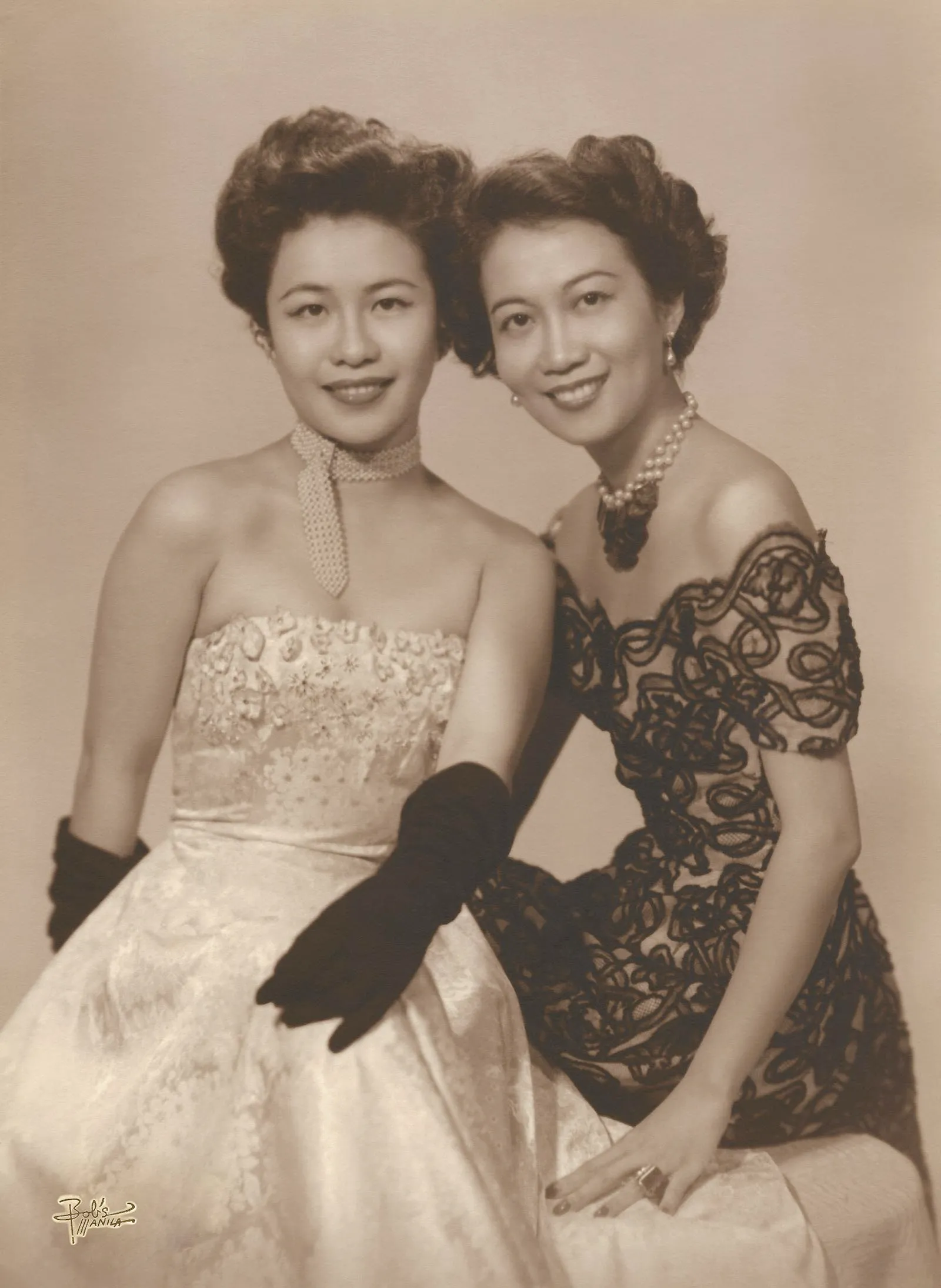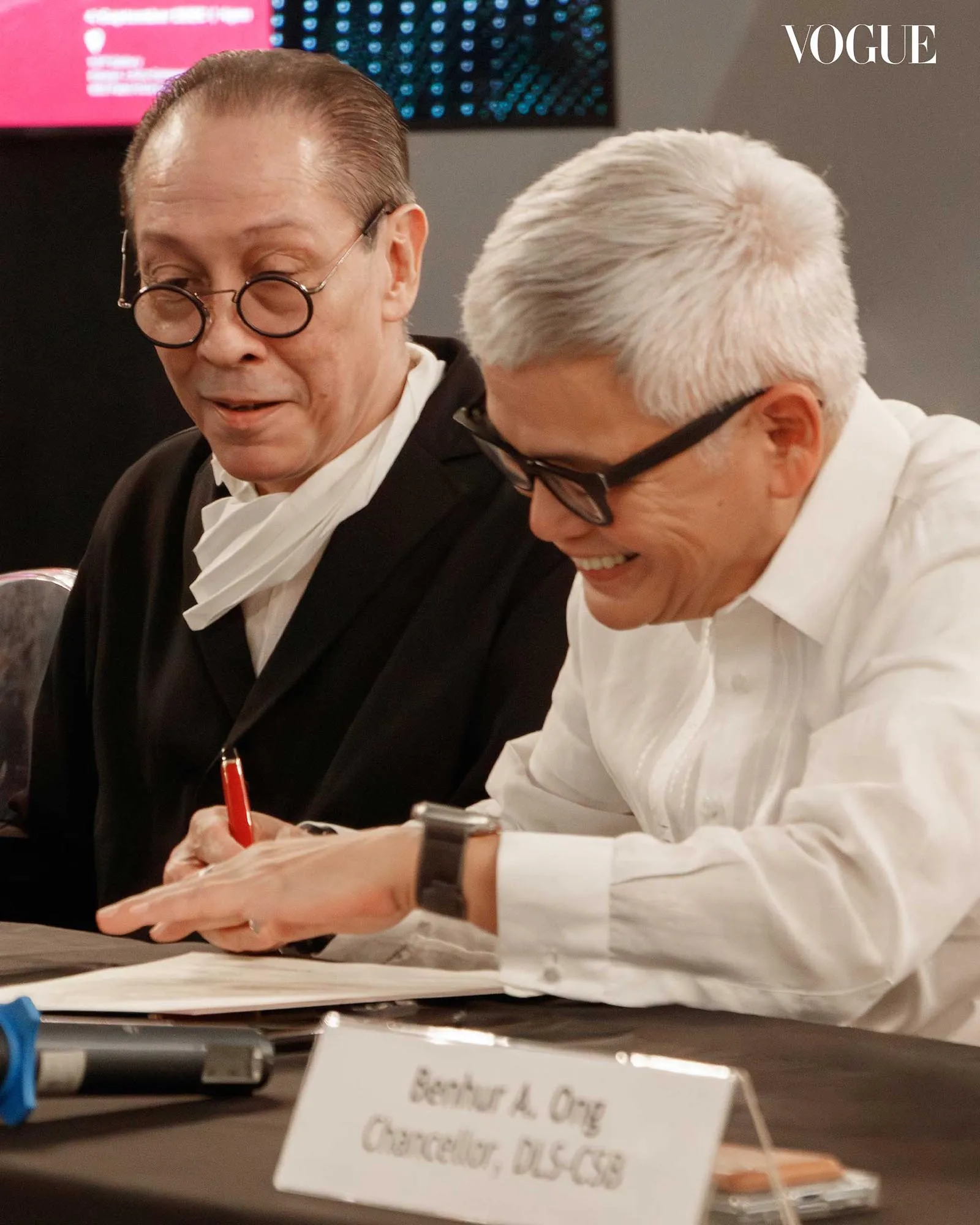A pearl grey silk satin terno that has been draped, slashed, and folded over to form a point, accented with mauve silk roses. Modeled by Edith Nakpil Rabat in 1956. Photograph courtesy of SLIM’s Fashion and Arts School
SLIM’s Fashion and Arts School, founded in 1960 by National Artist and designer Salvación Lim Higgins, was acquired by the College of St. Benilde. Art critic and curator Marian Pastor Roces writes on the origins of the agreement through to finalization.
SLIM’s Fashion and Arts School was acquired by the De La Salle-College of Saint Benilde (DLS-CSB). Announced September 4, 2025, the happy transfer of both ownership and custodianship is as worthy an event as it gets.
Full disclosure: I set the process of negotiation in motion by inviting Brother Edmundo “Dodo” Fernandez, FSC, President of CSB, to meet Mark Lewis Higgins, the sole remaining heir of Salvación Lim Higgins, SLIM’s founder. Rapport was immediate. However different their upbringing, Mark, a celebrated couturier’s son, and Bro. Dodo, son of an admired academic, mirrored each other.
They share polish, aesthetic bent, mission to teach, and sense of multi-generational duty. And a culture of management. Amazing to see.
Writing this annotated announcement now, I, however, switch quickly from the origin story to the substance of the agreement that came years later. In any case, after that meeting, it was Mark and Bro. Dodo all the way through to finalization.
The CSB academic and administrative hierarchy vetted Bro. Dodo’s proposal to purchase, through internal discussion that took up those years. Mark prepared for transition (not necessarily the turn-over to CSB) with further refinements to his already thoroughgoing documentation of the SLIM’s curriculum and archives—in itself a stunnng archiving project.
The two principals worked with teams who, in the run-up to the decision to purchase, began to make out the enormity of the moment—that is, a momentousness that couldn’t have been fully apparent at the get-go.

Ouevre
That first meeting at Mark’s was a quiet marveling at the singularity of SLIM, both school and founder, Laureate of the Order of National Artist for Design. Salvación Lim Higgins is the only National Artist to have founded a fashion design school, aside from metamorphosing herself into the consummate artist.
She had help. Higgins’ sister Purificación Lim was the administrative partner to the artist and co-founder of a school that ambitioned, 65 years ago, to center the fashion and clothing field in virtuoso abilities of making.
Not the school to only greenhouse people who draw and dream, SLIM’s is rather the builder’s guild, insisting on students’ technical dexterity.
SLIM’s teaches strategies for full throttle imagination—it did educate Michael Cinco, Gang Gomez, Joe Salazar, Martin Bautista, Oliver Tolentino, Joey Samson, Jo Ann Bitangcol, Ezra Santos, Chito Vijandre, Jaz Cerezo, and Barge Ramos, among hundreds of others—but reinforced by the discipline of couture.
SLIM’s students trained for bespoke cutting, tailoring, detailing, embellishing (including the expert creation of fabric-based embellishments), and to be sure, sculpting, architecting, and engineering clothes.

Buttonholes have to be Savile Row or nothing. All possible cloths have to be intellectually and voluptuously understood by the SLIM’s maker, because cloth, an assertive material, is contemptuous of unskilled designers.
Each tela insists on specific handling: the expert execution and direction of each cut, pleat, nip, tuck, seam, inseam, hem, trim, edging, joinery, angle of bias, and tie. Surgical precision is the accurate way to put it. Otherwise, this or that textile will not submit to any modest or elaborate plan.
Skills have been transferred at SLIM’s by a comprehensive library of Higgins’ patterns, from nearly all the couturier’s designs during her career, and then some. Developed by the sisters Salvación and Purificación at SLIM’s, the patternmaking curriculum is copyrighted and registered as “The SLIM’s Method.”
SLIM’s oeuvre attracts superlative description.
College and craftsmanship
The CSB School for the Arts is among the Philippines’ most unusual schools. It represents De La Salle University’s late sortie into the arts (and the other universities have been in art education, typically from more than a century ago), established only a few decades ago—with a bang.
It entered the world of Philippine education with an audacious multiplanar, multistory building by Architect Ed Calma, the country’s avatar of updated International Style. It dominates but does not seem out of place in a Manila district of 1970s street-level shops and a neoclassically designed religious-run university for women. Its design would not have been possible even a year before its commissioning: the computer-generated engineering had not yet been contrived.
The well-known genius President of La Salle, Bro. Andrew Gonzalez, FSC, thought to respond to a vacuum: college education for youth whose cognition profile is predominated by innovativeness. But not with a Fine Arts education, which would have been redundant to the offerings of many universities.
CSB, the outcome of his insight, trains youth for work in what are now called Creative Industries: a lively gamut of fields including music production, arts administration, animation, theatercraft and filmcraft, and, indeed, fashion design—all surrounding and conversing with the Fine Arts as constructed by universities and the Euro-American world until the mid-20th century.

Attention to the refined and disciplined craftsmanship of art—whether theater, music, the visual arts so-called, architecture, fashion, and so forth—now makes for CSB’s core competence.
SLIM’s pioneered this trajectory, except for Bro. Andrew’s bias for college-level education. That SLIM’S was imagined by SLIM to craft fashion as art drew from her College of Fine Arts education at the University of Santo Tomas. Decades later, Edmundo Fernandez would train in the College of Fine Arts at the University of the Philippines, before he became Bro. Dodo. Slightly before Bro. Dodo did, Mark took up Fine Arts in the United States.
The confluence is as striking as it is opportune. Things aligned: the need to reinforce the craftsmanship of art and to align this competency with tertiary accreditation.
Custodian, the humanist idea
CSB established a Fashion Museum this year, 2025, to occupy the early 20th-century building at the corner of Estrada and Leon Guinto, a gem of a Manila Brutalist structure. Mark is among the Advisory Board Members of this museum, as am I. It was commonsensical enough to stay with the negotiations, to get past each impasse.
The prescient Bro. Andrew and the pragmatic creative SLIM are now the dearly departed of their communities and circles. Mark’s beloved sister Sandra, too, has passed on. Sandra was the Purificación to Mark’s Salvación. The pioneers have left the future to a concept of custodianship as a clear succession plan. Mark’s loss of Sandra roused him to consider options other than continuing ownership to assure SLIM’s longevity.
In this instance of a school’s absorption into a much bigger institution, the new custodian takes up a living, breathing idea that some rather splendid individuals carried out not too long ago. The custodian keeps the idea alive: the culture of making things with Medieval fastidiousness—and, well, love—so that a Modernity and its Post- can keeping upping measures of quality.

That quality will be measured by this culture’s continued reinforcement of haute couture, and, by extension, all high-octane artistic endeavor. But this culture of making will also be judged by how long SLIM’s in Benilde will continue to welcome students from among women and men who ambition no more than a setting up a costurera shop, to become valued dressmakers, or to be proud workers of an atelier. SLIM’s has always served this demography, and CSB is committed to preserving this school ethos.
Three hundred of SLIM’s clothing, as well as alumni works, now reside in storage at the Benilde Fashion Museum. Soon to be turned over is the archive of press coverage dating to the beginning of SLIM the person’s career, and SLIM’s the school’s becoming over the past six decades. The archive also includes hundreds of vintage embellishments she designed, fashion photographs from 1947 to 1990, her original drawings, and her National Artist medal.
Custodianship, therefore, is watchfulness over the inevitable effects of time on the incunabulae of an enormous body of work. These materials and how they embody and explain dignity in work well done—and how masterfulness is inextricable from any prodigy turn of the imagination—ask to belong to whatever kind of humans emerge in the future.
CSB, in agreeing to take care of a school and archive, endures well as a humanist stronghold. And SLIM’s, having found a true custodian, carries on, like SLIM herself and her children: splendidly.
